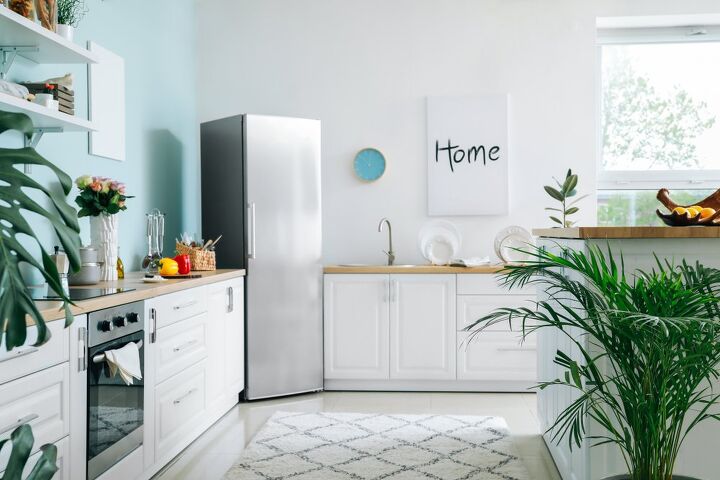Can Refrigerators Share an Outlet?

Your kitchen is one of the most important rooms in your entire house. It’s also the room that uses more electricity than most other parts of your home, excluding large appliances like air conditioners, dryers, and your furnace. There are many outlets in your kitchen, some of which can only have one appliance plugged into them at a time. You may have noticed that your refrigerator is plugged into its own outlet rather than sharing one with another appliance.
Your refrigerator should never share an outlet with another appliance or electronic device. Your fridge must have its own outlet, because of the high amount of electricity it requires. Plugging devices into the same outlet as your refrigerator will likely overload the circuit and cause the breaker to trip or your outlet to overheat and catch fire.
Electricians run multiple circuits to the kitchen for a good reason. Many of the appliances used in the kitchen, including your refrigerator, require a great deal of electricity to operate. Not overloading any of the circuits is extremely important for your safety and the smooth operation of your kitchen.
Does a Refrigerator Need a Dedicated Circuit?
Because of the amount of power a refrigerator requires to operate, it’s a good idea to put it on a dedicated circuit. A dedicated circuit means a breaker in your panel box whose only purpose is to provide power to the refrigerator. Nothing else in your kitchen or home is powered by the breaker outside of the fridge.
While this is a good idea, and most modern electricians practice it, a dedicated circuit for your refrigerator isn’t a requirement. According to the National Electrical Code (NEC), having your refrigerator on a dedicated circuit isn’t required. You can technically have it on one of the minimum two circuits running to your kitchen dedicated to small appliances. However, you’ll rarely find a home built today that doesn’t have the refrigerator on a dedicated circuit.
Is a Special Outlet Required for a Refrigerator?
While a refrigerator should always have its own circuit and never share an outlet, it doesn’t require a special outlet different from the rest in your home. Refrigerators can get plugged into any standard 110 or 120-volt outlet as long as it has room for three prongs. Most older outlets only had two prongs for the power source and neglected the third prong designed for grounding purposes.
As long as your refrigerator has its own three-prong, 110-120 volt outlet, you shouldn’t have any electrical issues. The third prong, below the upper vertical prongs, is round rather than straight. This prong is designed to ground the refrigerator and prevent it from shorting out or surging in power. It’s a safety feature that all refrigerators come equipped with and is mandatory for safe operation.
Wattage Requirements for a Refrigerator
There are many different types and sizes of refrigerators, and many of them have different wattage requirements. The average 21 cubic foot refrigerator, typical of most modern households, uses between 750 and 800 watts. Smaller refrigerators such as mini-fridges use closer to 500 watts. However, larger refrigerators with between 25 and 30 cubic feet of interior space can use upwards of 1,000 watts.
You must know the wattage requirements of your specific refrigerator. That way, you have a better idea of what size the electrical wire should be that’s powering its outlet. You can also have a better idea of what your monthly electric bill will be. However, regardless of the wattage requirements for your fridge, you should never plug it into a shared outlet.
Running Power Versus Startup Power
Another thing to consider with your refrigerator is the difference between running power and starting power. Voltage usage requirements are usually stated in running power.
- Running Power
Running power is the amount of electricity your refrigerator uses after it’s been plugged in and reaches its cooling temperature.
- Startup Power
On the other hand, startup power is the amount of voltage your refrigerator uses when the internal motor kicks on to initiate the cooling process. Your refrigerator works similarly to how your air conditioner does. There’s an internal thermostat that notifies the motor, fan, and condenser of your refrigerator if the fridge’s interior gets too warm. This will cause the condenser to activate, resulting in a surge of electricity.
Startup power is usually double the normal operating power of electrical devices and appliances. If your refrigerator uses 700 watts under normal circumstances, you should expect it to use around 1400 watts when the condenser turns on.
Risks of Plugging Your Refrigerator Into a Shared Outlet
The consequences of plugging your refrigerator into a shared outlet are too significant to make it worthwhile. These risks might seem minor at first, but they can cost you big bucks if you’re not careful.
Tripped Breaker
If you plug something into the same outlet as your refrigerators, such as a mixer or a blender, there’s a good chance that you’ll overload the circuit. When your circuit is overloaded, it will cause your breaker to trip if it’s installed correctly. Breakers are meant as a safety measure to cut power to a specific circuit when it senses that there’s too much electricity.
Tripped breakers are an inconvenience because you’ll have to go to your panel box, find the tripped breaker, and reset it. This is especially inconvenient if some of the lights in your home happen to be on the same circuit as your refrigerator, which wasn’t uncommon in older houses. It’s never fun stumbling through the dark to undo a mistake you made.
Blown or Burned-Out Fuse
Certain outlets and devices have internal fuses that can burn out or melt when the temperature gets too high. If you overload the circuit your refrigerator is on, there’s a chance that a fuse in the outlet, your refrigerator, or the other device you plugged in will have a burned-out fuse. Fuses aren’t overly expensive to replace, but they’re a pain and an inconvenience.
Spoiled Food
Anytime your refrigerator stops running for any period of time, there’s a chance that the food and drink inside it will spoil. This is especially true if you plug something into your refrigerator’s outlet that constantly draws power. The danger is that your circuit may not be overloaded right at first. However, when the refrigerator’s condenser starts up to cool down its interior, the surge of electricity is enough to overwhelm the circuit and trip the breaker.
If this happens in the middle of the night, you won’t be aware of the problem until the morning. This could also occur while you’re away from home, and the problem goes unnoticed for several days. By the time you notice the issue, all the food and drink in your fridge and freezer will have spoiled. If you’ve ever had to clean rotten food out of a fridge or freezer, you know what a smelly inconvenience this is.

Before I started writing, I worked for 6 plus years in the plumbing, electrical, and HVAC business. I was primarily an HVAC installer but also worked as a plumber and electrician. Now I'm a copywriter, focusing on home improvement content and guides.
More by Jalin Coblentz










![10 Best Cordless Leaf Blowers – [2022 Reviews & Ultimate Guide]](https://cdn-fastly.upgradedhome.com/media/2023/07/31/9070789/10-best-cordless-leaf-blowers-2022-reviews-ultimate-guide.jpg?size=350x220)
















